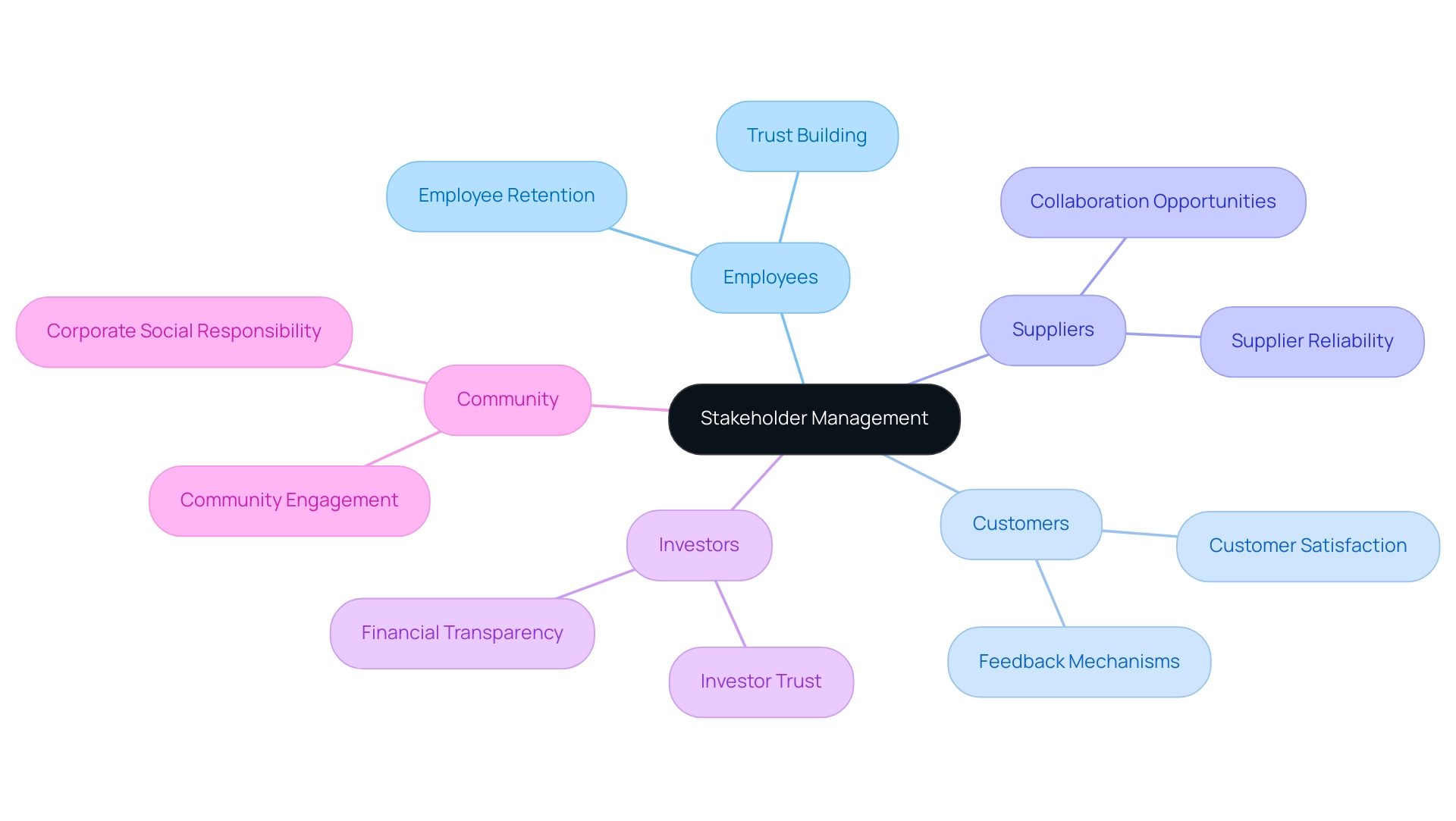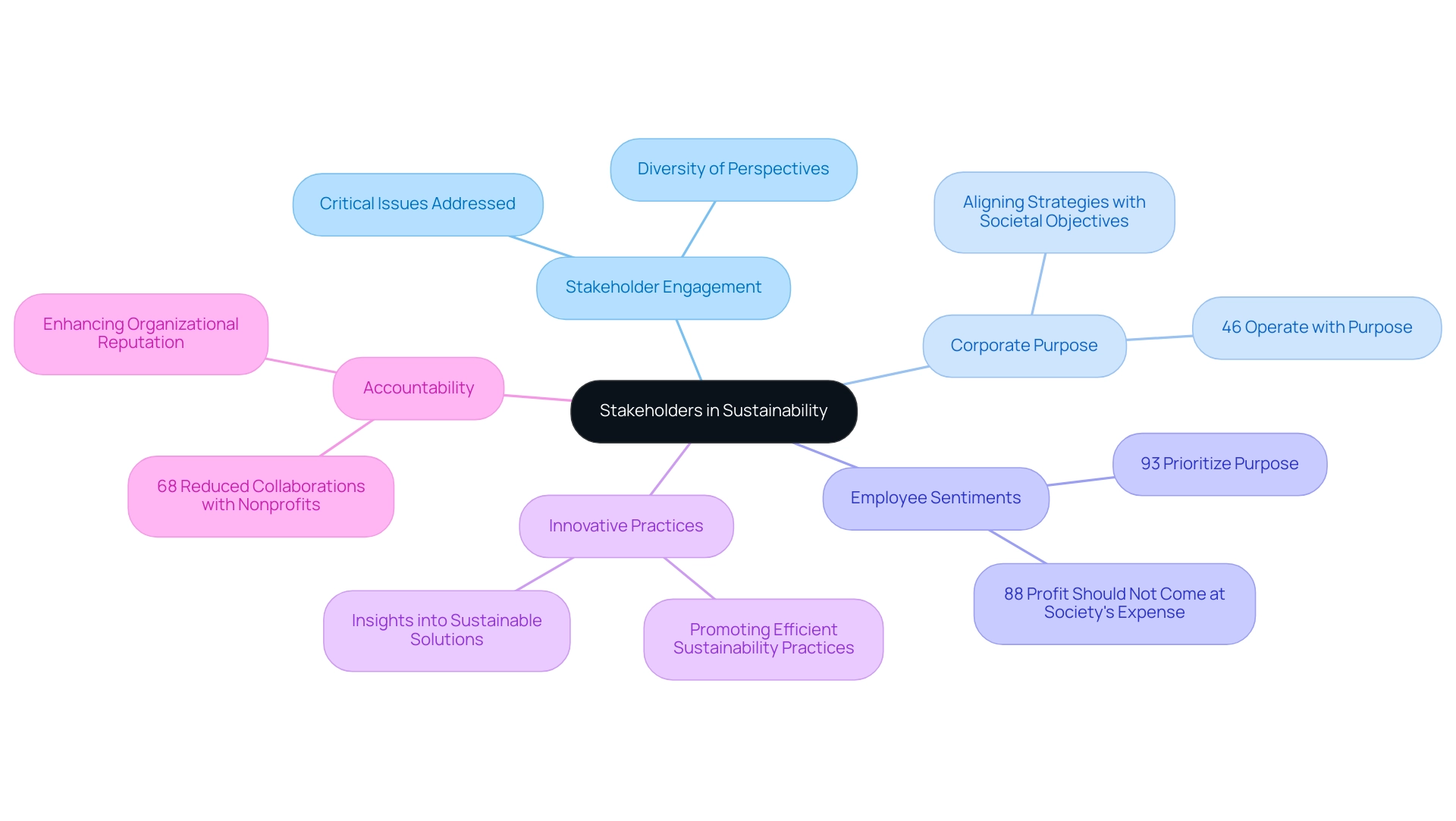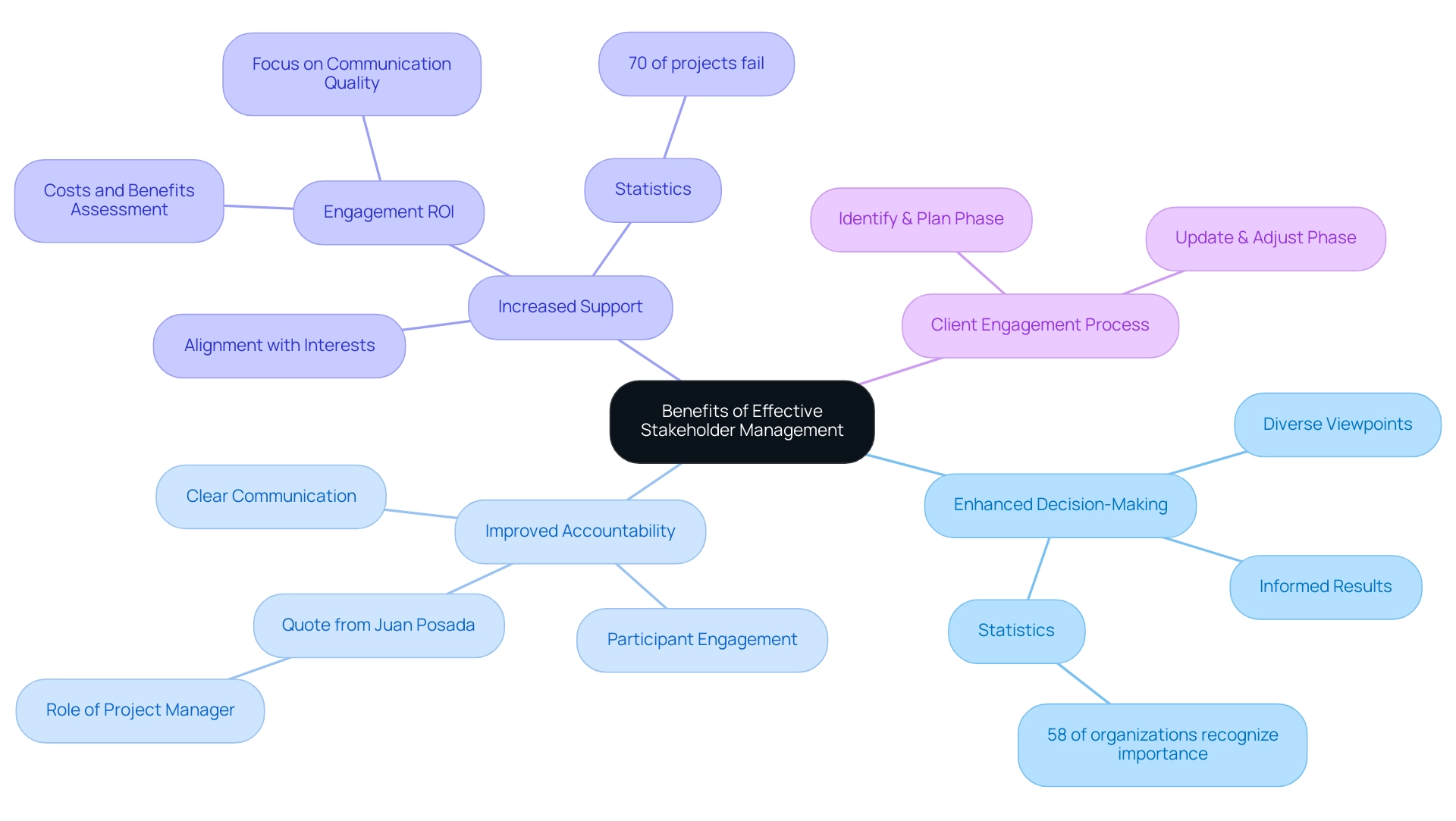Overview
The key objectives of stakeholder management are to systematically engage stakeholders, build strong relationships, and ensure their satisfaction, which is crucial for organizational success. The article emphasizes that effective stakeholder management enhances collaboration, mitigates risks, and improves overall performance through clear communication and active involvement of interested parties, ultimately leading to better decision-making and accountability.
Introduction
In the complex landscape of modern organizations, stakeholder management emerges as a pivotal element that can significantly influence success. It involves a meticulous approach to identifying and engaging individuals or groups with vested interests, ranging from employees and customers to investors and the community. Effective stakeholder engagement not only nurtures positive relationships but also enhances satisfaction and mitigates risks, especially during turbulent times.
As businesses navigate challenges, understanding the dynamics of stakeholder relationships becomes essential. By implementing strategic engagement practices, organizations can streamline decision-making, foster collaboration, and ultimately drive better outcomes.
The importance of this discipline is underscored by statistics revealing that a substantial percentage of projects fail due to misalignment with stakeholder objectives, highlighting the critical need for robust engagement strategies.
Understanding Stakeholder Management: Definitions and Importance
The key objective of stakeholder management is to encompass the systematic identification, analysis, planning, and execution of strategies aimed at engaging stakeholders—individuals or groups with vested interests in the outcomes of an organization, such as employees, customers, suppliers, investors, and the community. The key objective of stakeholder management is to effectively manage involved parties, which plays a crucial role in cultivating positive relationships that enhance satisfaction and mitigate potential risks, especially during challenging periods such as crises or restructurings. Our client interaction process starts with a thorough business assessment that aligns essential participants and enhances our comprehension of your business beyond the figures.
By collaboratively identifying underlying business issues and creating strategic plans, we can streamline decision-making and utilize real-time analytics to monitor business performance. A staggering 44% of projects fail primarily due to a lack of alignment between business and project objectives, highlighting that the key objective of stakeholder management is ensuring strong participant involvement practices. Furthermore, building trust with interested parties demonstrates that the key objective of stakeholder management is to achieve a 10% better employee retention in tech, illustrating how effective engagement can positively impact organizational performance.
Significantly, 50% of a company’s worth frequently arises from merely 15-20 essential positions, highlighting the importance of prioritizing relationships with interested parties. Grasping the intricate dynamics of these relationships is crucial, as the key objective of stakeholder management is a company's success. By fostering targeted engagement strategies, entities can significantly enhance participant contributions, such as improved communication and collaboration, leading to better overall performance and agility.

Key Objectives of Stakeholder Management: Building Relationships and Ensuring Satisfaction
Effective management of involved parties is crucial for entities seeking to promote collaboration and attain strategic objectives. The key objective of stakeholder management is to build strong relationships, ensure the satisfaction of interested parties, and facilitate effective communication. Our team endorses a shortened decision-making cycle throughout the turnaround process, enabling your entity to take decisive action and preserve business integrity.
Building strong relationships relies on comprehending the needs and expectations of involved parties, fostering increased trust and collaboration. Notably, research indicates that building trust can result in a 10% improvement in employee retention within the tech sector, a clear testament to the value of these relationships. Continuous business performance monitoring through our client dashboard, which provides real-time analytics, enables entities to assess their health and make necessary adjustments.
The key objective of stakeholder management is to meet or exceed the expectations of involved parties, which is vital for ensuring satisfaction and enhancing loyalty and support for organizational initiatives. Effective communication plays a crucial role in this process, keeping interested parties informed and engaged as organizations navigate challenges. As manager Marc G. states, 'Easy to use, it ensures a quick start without constraining training,' highlighting the importance of straightforward communication tools in managing participants.
Our commitment to identifying underlying business issues enables us to collaboratively create plans that mitigate weaknesses and reinvest in key strengths. Additionally, we adopt a pragmatic approach by testing and measuring every hypothesis to ensure maximum return on invested capital in both the short and long term. The case study titled 'Engagement ROI: Quantifying the Value of Stakeholder Involvement' illustrates how assessing communication quality and task completion aligns with objectives, ultimately enhancing plans and managing risks.
Moreover, targeted interaction strategies, exemplified by firms such as Bentley and Rolls-Royce, emphasize personal service and quality to improve participant contributions. By prioritizing these objectives and acknowledging the dynamic role of a project manager, entities can cultivate a supportive environment conducive to collaboration and success.
Creating an Effective Stakeholder Engagement Plan: Steps and Best Practices
Creating a strong participant involvement strategy is crucial for ensuring that the key objective of stakeholder management is effective communication and decision-making within organizations. The process begins with the identification of involved parties, categorizing them based on their influence and interests. This segmentation allows for targeted engagement, addressing the unique needs and expectations of each group.
Utilizing tools such as surveys or interviews can provide valuable insights into interested parties' perspectives, which should be carefully assessed. As a large global furniture brand illustrates, using tools like Simply Stakeholders helps track and manage complex internal relationships for effective collaboration. Once insights are gathered, the next step is to craft clear communication strategies tailored to various groups, ensuring that messages resonate and engage effectively.
Implementation involves engaging interested parties through various channels—meetings, newsletters, or social media—facilitating a continuous dialogue. Frequent assessment of these involvement initiatives is essential; including input from participants results in improved communication tactics and better involvement results. Statistics show that a thoroughly documented participant involvement strategy (SEP) greatly enhances the participation and impact of involved parties.
This is evidenced by a case study highlighting the necessity of revising participation plans based on feedback and observed behavior changes, leading to more effective communication strategies. Best practices in this endeavor include:
- Maintaining transparency
- Proactively communicating
- Fostering a two-way dialogue
As the key objective of stakeholder management is to cultivate trust, by following these principles, entities can develop engagement strategies that not only fulfill the requirements of their participants but also promote overall project success.
The Role of Stakeholders in Sustainability: Engaging for Better Outcomes
The key objective of stakeholder management is to recognize that stakeholders are integral to the success of sustainability initiatives, significantly influencing environmental, social, and governance (ESG) outcomes. Engaging these key players enables entities to address critical issues and gather a diversity of perspectives; thus, the key objective of stakeholder management is to enhance accountability. A significant statistic shows that 68% of entities have reduced or terminated collaborations with nonprofits in favor of new initiatives, indicating a shift in focus that can affect relationships with involved parties.
Furthermore, research shows that 93% of employees believe companies should prioritize purpose, with 88% asserting that profit should not come at society's expense. This sentiment emphasizes the necessity for a strong corporate purpose—only 46% of executives report that their entities currently operate with this mindset. By actively engaging interested parties, such as community members in environmental evaluations, groups can promote more efficient and broadly accepted sustainability practices.
Stakeholders also drive innovation by offering valuable insights into sustainable practices and solutions. Therefore, the key objective of stakeholder management is to prioritize the involvement of interested parties, which not only encourages a more inclusive method to sustainability but also aligns corporate strategies with wider societal objectives, ultimately enhancing organizational reputation and nurturing long-term success. The alignment of employee expectations with participant involvement in CSR initiatives indicates that organizations must create and convey their purpose-driven strategies to address both participant and employee needs.

Challenges in Stakeholder Engagement: Identifying and Overcoming Obstacles
The effectiveness of participant engagement is often hampered by several challenges, including:
- Miscommunication
- Conflicting interests
- Varying levels of involvement
Recent reports suggest that miscommunication can result in significant misunderstandings, undermining stakeholder satisfaction and jeopardizing outcomes. In fact, entities that employ formal management methods report that 73% of them often achieve their goals, illustrating the significance of structured communication.
Additionally, 59% of organizations that use formal project management delivered projects on time, highlighting the critical role that structured communication plays in achieving project success. Conflicting interests among participants can further complicate collaboration, as differing priorities may obstruct consensus and decision-making. Furthermore, some participants may feel disengaged or underestimate their role in the process, leading to a lack of participation.
To tackle these challenges, the key objective of stakeholder management is to prioritize clear and consistent communication to ensure that all parties are informed and engaged. The key objectives of stakeholder management are:
- Actively involving participants in decision-making processes and addressing their concerns, which is crucial.
- Building trust through transparency and responsiveness to significantly mitigate these challenges.
By promoting a culture of teamwork and open communication, firms not only enhance participant involvement but also create conditions for better initiative success—supported by the fact that companies with effective participant strategies are 40% more likely to finish initiatives on time and within budget.
The five essential phases of the PM lifecycle—initiative, planning, execution, monitoring and control, and closure—serve as an organized framework for understanding the management process and its significance to participants. As we advance into 2024, concentrating on overcoming these obstacles will be crucial for entities seeking to enhance participant involvement and accomplish their strategic goals.
Benefits of Effective Stakeholder Management: Enhancing Decision-Making and Accountability
Effective management of involved parties is crucial for successful execution, and the key objective of stakeholder management is to yield numerous advantages such as enhanced decision-making, improved accountability, and increased support from participants. The key objective of stakeholder management is to involve interested parties in the decision-making process, enabling groups to access a wealth of diverse viewpoints, which leads to more informed and balanced results. Recent findings emphasize that 58% of organizations acknowledge the importance of management, yet a staggering 70% of initiatives fail, often due to insufficient involvement from top leaders.
Significantly, 87% of senior program managers recognize that the key objective of stakeholder management is the importance of management practices, which stresses the necessity of participant involvement and supervision in achieving success. By promoting clear communication and involvement, accountability is significantly enhanced, encouraging a sense of ownership among participants. This sentiment is echoed by Juan Posada, Senior Marketing & Communication Officer, who notes,
The role of a manager is not just someone overseeing the task in question, but needs to be a leader, confidante, team member, and showcase so many more approaches to work that they do not just become a key cog in the business, but are clearly the most indispensable part.
Furthermore, the key objective of stakeholder management is to effectively manage involved parties, which translates to increased support for initiatives, as these individuals are more inclined to endorse decisions that align with their interests and concerns. The concept of Engagement ROI reinforces this notion by evaluating the costs and benefits of participant involvement, focusing on communication quality, task completion, and alignment with project goals. Organizations that assess participation ROI can refine their strategies, manage risks effectively, and garner sustained support for their programs.
By prioritizing effective resource planning and ensuring the satisfaction of involved parties, organizations fulfill the key objective of stakeholder management, which is to navigate challenges and achieve sustainable success. To support this, our client engagement process begins with a comprehensive business review that aligns key stakeholders and identifies underlying business issues. In the 'Identify & Plan' phase, we work collaboratively to create a strategic plan that mitigates weaknesses while reinforcing strengths.
Throughout the turnaround process, our team facilitates streamlined decision-making cycles and employs real-time analytics to monitor performance and business health. We continually assess progress through the 'Update & Adjust' phase, ensuring that lessons learned are operationalized for future endeavors.

Conclusion
Effective stakeholder management is not merely an organizational strategy; it is a fundamental aspect that influences overall success and sustainability. The article highlights the critical role of engaging stakeholders—ranging from employees to community members—and the significant impact this engagement has on decision-making, risk mitigation, and project outcomes. With statistics indicating that a considerable percentage of projects fail due to misalignment with stakeholder objectives, it becomes evident that robust engagement strategies are essential.
By prioritizing clear communication, fostering trust, and actively involving stakeholders in the decision-making process, organizations can enhance collaboration and accountability. The emphasis on tailored engagement plans that address the unique needs of different stakeholder groups further reinforces the importance of understanding and responding to diverse perspectives. As demonstrated through various case studies, effective stakeholder engagement not only improves project performance but also cultivates a supportive environment conducive to innovation and long-term success.
As organizations continue to navigate complexities in their operations and strive for sustainability, the lessons drawn from effective stakeholder management practices are invaluable. The alignment of stakeholder interests with corporate objectives is not just beneficial but necessary for achieving desired outcomes. By committing to these principles and continuously refining engagement strategies, organizations can strengthen their foundation for success, ensuring they are better equipped to meet both current challenges and future opportunities.
Frequently Asked Questions
What is the key objective of stakeholder management?
The key objective of stakeholder management is to systematically identify, analyze, plan, and execute strategies to engage stakeholders—individuals or groups with vested interests in an organization’s outcomes—ultimately cultivating positive relationships, enhancing satisfaction, and mitigating potential risks.
Why is stakeholder management important during challenging periods?
Effective stakeholder management is crucial during challenging periods, such as crises or restructurings, as it helps maintain positive relationships and ensures that the needs and expectations of involved parties are met, which can enhance loyalty and support for organizational initiatives.
How does stakeholder management impact project success?
A significant 44% of projects fail due to a lack of alignment between business and project objectives. Stakeholder management ensures strong participant involvement practices, which are essential for successful project execution.
What role does trust play in stakeholder management?
Building trust with stakeholders can lead to a 10% improvement in employee retention, particularly in the tech sector, demonstrating that effective engagement and strong relationships positively impact organizational performance.
How can organizations enhance stakeholder contributions?
Organizations can enhance stakeholder contributions through targeted engagement strategies that improve communication and collaboration, leading to better overall performance and agility.
What tools are used to monitor business performance in stakeholder management?
Continuous business performance monitoring is facilitated through a client dashboard that provides real-time analytics, enabling organizations to assess their health and make necessary adjustments.
What is the significance of understanding stakeholder needs and expectations?
Understanding the needs and expectations of stakeholders is vital for building strong relationships, fostering trust and collaboration, and ensuring satisfaction, which enhances loyalty and support for organizational initiatives.
How do targeted interaction strategies improve stakeholder engagement?
Targeted interaction strategies, such as those employed by firms like Bentley and Rolls-Royce, emphasize personal service and quality, which can significantly improve stakeholder contributions and overall engagement.
What approach does the article suggest for addressing underlying business issues?
The article suggests a collaborative approach to identify underlying business issues and create strategic plans that mitigate weaknesses while reinvesting in key strengths, ensuring maximum return on invested capital in both the short and long term.




